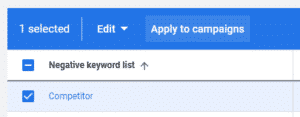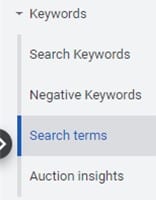WHAT ARE NEGATIVE KEYWORDS?
A negative keyword is a keyword that prevents your ad to be triggered by a word or phrase. For example, adding the word “free” as a negative keyword to your campaign or ad group. You are telling Google to not show your ad for any search term containing “free”.
Negative keywords are used to prevent your ads from being shown in unrelated search results. In return, this gives your business the opportunity to reach out to a potential audience, while avoiding wasting money on clicks that will likely not convert. These set keywords can be used in your campaigns to prevent certain keywords from triggering your ad or campaign to be shown.
WHY ARE THEY IMPORTANT?
Negative keywords help to filter out any unwanted clicks that won’t turn into conversions for your ads. An example would be if your bidding on a phrase match keyword “family hotel Dublin” and you show up for the search term “family hotel Dublin with swimming pool” and you do not have a swimming pool, you would add ‘swimming pool’ to your negative keyword list as people looking for a swimming pool will not book for your hotel. . We use negative keywords to prevent our ads from being shown when a user searches for this keyword.
By doing this we are targeting an audience that is relevant to what we are marketing. Using negative keywords helps target our ads towards the relevant audience and get a higher ROI (Return on Investment).
WHAT HAPPENS WHEN YOU IGNORE THEM?
By ignoring negative keywords, targeting the audience you want, will become difficult. This is because your ad may be shown for any search term that your keywords may pull in. When you serve ads for what are know as low-quality search terms, any clicks on those ads are a wasted budget. By adding negative keywords, we are less likely to waste our budget on non-relevant clicks.
To top it all off, no conversions are to be made which in the end can harm the account.
HOW TO CREATE A NEGATIVE KEYWORD LIST FOR YOUR NEW ACCOUNT
To create a negative keyword list, we click the Tools & Settings icon at the top of the Google Ads UI and then click on ‘Negative keyword lists’.

From there you will see the blue plus sign which when clicked will create your new list of negative keywords. Give your list a name – for example, “Competitors” – and in the ‘Add negative keywords’ box, for a “Competitors” list, you would put all your competitors’ names. Ensure that these competitors names are entered as broad match keywords to capture any misspellings or queries involving the competitor’s name as part of a longer phrase (exceptions to this include when a competitor’s name might be very generic: for example, if you make digital videos, and you have a competitor named Best Digital Videos, you wouldn’t want to make that a negative keyword)
It really is the simple, but negative keywords are one of the most frequently overlooked parts of a new account set up!

Now if you have an existing campaign and you want to add your new list of negative keywords, we simply go back to the Negative keyword list library, select your list, and click ‘Apply to campaigns’.

From there, choose the campaign(s) you want to add the negative keyword list to and click Apply.

HOW TO REVIEW AN EXISTING ACCOUNT FOR NEW NEGATIVE KEYWORDS
To find out if your ad is appearing in for search terms that aren’t valuable to your business, we simply click on the keywords tab in any campaign, and then onto search terms.
From here, you can see what people are searching for when your ads are served. If you find a search term which does not relate to your product or service, open up a notes app or take out a notepad – write down the irrelevant words from each query that doesn’t work for your business.
For example, if you see ‘Directions to X hotel’, you don’t want your ads to serve for ‘directions’- those aren’t people trying to book X hotel, those are just people trying to get there! When you have your full list of words to exclude, add them to the relevant Negative Keyword List – this may be your competitor list, a list of questions that are irrelevant to purchases, or simply a list of generic negative keywords. Make sure you add them as broad match.
Once that’s done, your ad will not be triggered by those unrelated search terms. Best practice would be to complete this task once a week for your high traffic campaigns, and at least once a month for lower-traffic campaigns.
We hope that you now understand how important negative keywords are and how to review them. Remember, negative keywords help control who will see your ad, and help you ensure the traffic you get comes from the right audience.






